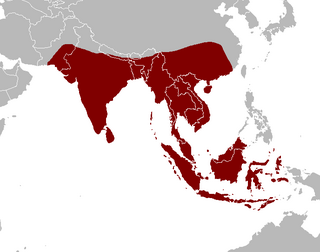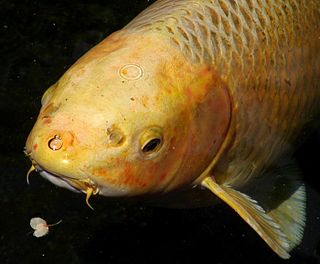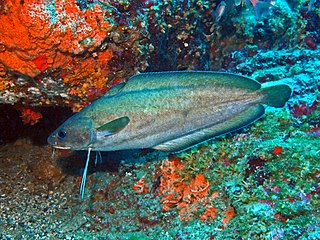
The poor cod is a temperate marine fish belonging to the cod family (Gadidae). It is red brown in colour and has a pronounced chin barbel. It may grow up to a length of 40 cm. It is usually found in small shoals at depths between 10 and 300 metres on muddy or sandy bottoms. Its distribution spans the eastern Atlantic, from Norwegian coasts to Portugal and along the Atlantic coast of Morocco. Spawning takes place towards the end of winter. They are often regarded as a mini species and are commonly confused with pouting as they have a similar appearance. They are often seen as a menace for anglers and have little commercial value and so are not currently at any risk of extinction.

Stomiiformes is an order of deep-sea ray-finned fishes of very diverse morphology. It includes, for example, dragonfishes, lightfishes, loosejaws, marine hatchetfishes and viperfishes. The order contains 4 families with more than 50 genera and at least 410 species. As usual for deep-sea fishes, there are few common names for species of the order, but the Stomiiformes as a whole are often called dragonfishes and allies or simply stomiiforms.

The goatfishes are fish of the family Mullidae, the only family in the order Mulliformes. The family is also sometimes referred to as the red mullets, which also refers more narrowly to the genus Mullus.

The Mochokidae are a family of catfishes that are known as the squeakers or known as upside-down catfish. There are nine genera and about 200 species of mochokids. All the mochokids are freshwater species originating from Africa.

The brown bullhead is a fish of the family Ictaluridae that is widely distributed in North America. It is a species of bullhead catfish and is similar to the black bullhead and yellow bullhead. It was originally described as Pimelodus nebulosus by Charles Alexandre Lesueur in 1819, and is also referred to as Ictalurus nebulosus.

Leftvents are small, deep-sea lophiiform fish comprising the family Linophrynidae distributed throughout tropical to subtropical waters of all oceans.

Trichomycteridae is a family of catfishes commonly known as pencil catfishes or parasitic catfishes. This family includes the candiru fish, feared by some people for its alleged habit of entering into the urethra of humans. They are one of the few parasitic chordates. Another species is the life monsefuano which was important to the Moche culture and still an important part of Peruvian cuisine.

Stomiidae is a family of deep-sea ray-finned fish, including the barbeled dragonfishes. They are quite small, usually around 15 cm, up to 26 cm. These fish are apex predators and have enormous jaws filled with fang-like teeth. They are also able to hinge the neurocranium and upper-jaw system, which leads to the opening of the jaw to more than 100 degrees. This ability allows them to consume extremely large prey, often 50% greater than their standard length.

The stream catfishes comprise the family Akysidae of catfishes.

The shark catfishes form the family Pangasiidae. They are found in fresh and brackish waters across southern Asia, from Pakistan to Borneo. Among the 30-odd members of this family is the plant-eating, endangered Mekong giant catfish Pangasianodon gigas, one of the largest known freshwater fish. Several species are the basis of productive aquaculture industries in Vietnam's Mekong Delta.

In fish anatomy and turtle anatomy, a barbel is a slender, whiskerlike sensory organ near the mouth. Fish that have barbels include the catfish, the carp, the goatfish, the hagfish, the sturgeon, the zebrafish, the black dragonfish and some species of shark such as the sawshark. Barbels house the taste buds of such fish and are used to search for food in murky water.

Bairdiella chrysoura, the American silver perch, silver croaker or goldtail croaker, is a species of marine ray-finned fish belonging to the family Sciaenidae, the drums and croakers. This species is widespread along the eastern cost of North America and is commonly caught by inshore anglers in search of larger species. This fish is common up to 20 cm (7.9 in), but can be found uncommonly to 30 cm (12 in).
Parascylliidae, or the collared carpet sharks, is a family of sharks in the order Orectolobiformes, which are only found in shallow waters of the western Pacific. The family Parascylliidae contains two genera, Cirrhoscyllium and Parascyllium. They are relatively small sharks, with the largest species reaching no more than 91.0 cm in adult length. They have elongated, slender bodies, cat-like eyes, and barbels behind their chins. They feed on small fish and invertebrates.

The dash-and-dot goatfish is a species of goatfish native to the Indian and Pacific oceans.

Nematogenys inermis is a species of mountain catfish, the only extant species in the family Nematogenyiidae. This species is endemic to Chile where it is found in fresh waters in central Chile. This species grows to a length of 40.7 cm (16.0 in) NG.

Hapalogenys, the barbeled grunters or velveltchins, is a genus of marine ray-finned fish, it is the only genus in the monotypic family Hapalogenyidae, also spelled Hapalogeniidae. The species of this genus are found in depths between 30 and 230 m in coastal areas and river mouths from the shores of southern Japan to the Bay of Bengal and Northwestern Australia.
Grammatostomias flagellibarba is a species of barbeled dragonfish. They live at depths of up to 1,500 m below the surface and usually measure up to 15.2 cm in length.

Parupeneus pleurostigma, commonly known as the sidespot goatfish and round-spot goatfish, is a marine fish belonging to the family Mullidae.

Trachyrincinae is a subfamily of the family Macrouridae, also known as rattails. The subfamily contains two genera found in Atlantic, Indian and Pacific Ocean. These species lives in deep-water. These fishes have a long, narrow and sharply pointed snout. The chin barbel is present.

Phycis phycis, the forkbeard, is a species of phycid hakes in the family Phycidae.


















